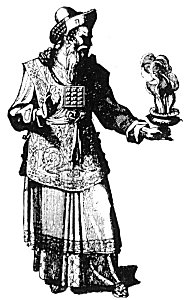“Now the vestment of the high-priest being made of linen, signified the earth; the blue denoted the sky, being like lightning in its pomegranates, and in the noise of the bells resembling thunder. And for the Ephod, it showed that God had made the universe of four (elements); and as for the gold interwoven, * * * it related to the splendor by which all things are enlightened. He also appointed the breastplate to be placed in the middle of the Ephod, to resemble the earth, for that has the very middle place of the world. And the girdle which encompassed the high-priest round signified the ocean, for that goes round about and includes the universe. Each of the sardonyxes declares to us the sun and the moon, those, I mean, that were in the nature of buttons on the high-priest’s shoulders. And for the twelve stones, whether we understand by them the months, or whether we understand the like number of the signs of that circle which the Greeks call the Zodiac, we shall not be mistaken in their meaning. And for the mitre, which was of a blue colour, it seems to me to mean heaven; for how otherwise could the name of God be inscribed upon it? That it was also illustrated with a crown, and that of gold also, is because of that splendour with which God is pleased.” It is also symbolically significant that the Tabernacle was built in seven months and dedicated to God at the time of the new moon.
The metals used in the building of the Tabernacle were all emblematic. Gold represents spirituality, and the golden plates laid over the shittim-wood were emblems of the spiritual nature which glorifies the human nature symbolized by the wood. Mystics have taught that man’s physical body is surrounded by a series of invisible bodies of diverse colors and great splendor. In the majority of people the spiritual nature is concealed and imprisoned in the material nature, but in a few this internal constitution has been objectified and the spiritual nature is outside, so that it surrounds man’s personality with a great radiance.
Silver, used as the capitals for the pillars, has its reference to the moon, which was sacred to the Jews and the Egyptians alike. The priests held secret ritualistic ceremonies at the time of the new and the full moon, both of which periods were sacred to Jehovah. Silver, so the ancients taught, was gold with its sun-ray turned inward instead of objectified. While gold symbolized the spiritual soul, silver represented the purified and regenerated human nature of man.
The brass used in the outer altars was a composite substance consisting of an alloy of precious and base metals. Thus, it represented the constitution of the average individual, who is a combination of both the higher and the lower elements.
The three divisions of the Tabernacle should have a special interest to Freemasons, for they represent the three degrees of the Blue Lodge, while the three orders of priests who served the Tabernacle are preserved to modern Masonry as the Entered Apprentice, the Fellow Craftsman, and the Master Mason. The Hawaiian Islanders built a Tabernacle not unlike that of the Jews, except that their rooms were one above another and not one behind another, as in the case of the Tabernacle of the Israelites. The three rooms are also the three important chambers of the Great Pyramid of Gizeh.
THE ROBES OF GLORY
As explained in the quotation from Josephus, the robes and adornments of the Jewish priests had a secret significance, and even to this day there is a religious cipher language concealed in the colors, forms, and uses of sacred garments, not only among the Christian and Jewish priests but also among pagan religions. The vestments of the Tabernacle priests were called Cahanææ; those of the High Priest were termed Cahanææ Rabbæ. Over the Machanese, an undergarment resembling short trousers, they wore the Chethone, a finely woven linen robe, which reached to the ground and had long sleeves tied to the arms of the wearer. A brightly embroidered sash, twisted several times around the waist (a little higher than is customary), with one end pendent in front, and a closely fitting linen cap, designated Masnaemphthes, completed the costume of the ordinary priest.
THE GARMENTS OF GLORY.
From Mosaize Historie der Hebreeuwse Kerke. Th. robe of the High Priest of Israel were often called “The Garments of Glory”, for they resembled the regenerated and spiritualized nature of man, symbolized by a vestment which all must weave from the threads of character and virtue before they can become High Priests after the Order of Melchizedek.

Moe is the founder of GnosticWarrior.com. He is a father, husband, author, martial arts black belt, and an expert in Gnosticism, the occult, and esotericism.





